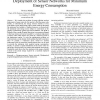69 search results - page 5 / 14 » Self-Organizing Spatial Regions for Sensor Network Infrastru... |
EXPERT
2006
13 years 7 months ago
2006
abstraction rules that hide the complexity of systems of components. We've begun this process in the domain of sensor/actuator network applications, observing that in manyappl...
SUTC
2008
IEEE
14 years 2 months ago
2008
IEEE
Most of research efforts have elaborated on k-anonymity for location privacy. The general architecture for implementing k-anonymity is that there is one trusted server (referred t...
EDBT
2006
ACM
14 years 7 months ago
2006
ACM
Abstract. Sensor networks monitor physical phenomena over large geographic regions. Scientists can gain valuable insight into these phenomena, if they understand the underlying dat...
IPSN
2005
Springer
14 years 1 months ago
2005
Springer
— We consider the problem of energy efficient random deployment of sensor network. Our goal is to find the sensor node density, or alternatively, the energy resource density at e...
SAC
2011
ACM
12 years 10 months ago
2011
ACM
A moving region whose location and extend change over time can imply topological changes such as region split and hole formation. To study this phenomenon is useful in many applic...

